
Italian East Africa was an Italian colony in the Horn of Africa. It was formed in 1936 through the merger of Italian Somalia, Italian Eritrea, and the newly occupied Ethiopian Empire, conquered in the Second Italo-Ethiopian War.
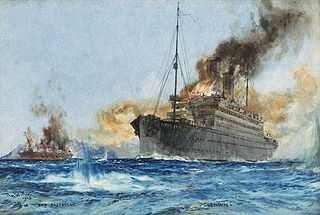
Merchant raiders are armed commerce raiding ships that disguise themselves as non-combatant merchant vessels.
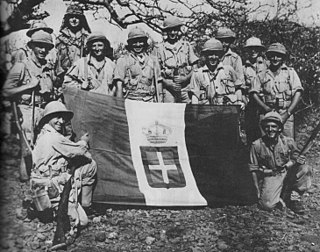
The East African campaign was fought in East Africa during the Second World War by Allies of World War II, mainly from the British Empire, against Italy and its colony of Italian East Africa, between June 1940 and November 1941. The British Middle East Command with troops from the United Kingdom, South Africa, British India, Uganda Protectorate, Kenya, Somaliland, West Africa, Northern and Southern Rhodesia, Sudan and Nyasaland participated in the campaign. These were joined by the Allied Force Publique of Belgian Congo, Imperial Ethiopian Arbegnoch and a small unit of Free French.

The Regia Marina or Royal Italian Navy was the navy of the Kingdom of Italy from 1861 to 1946. In 1946, with the birth of the Italian Republic, the Regia Marina changed its name to Marina Militare.
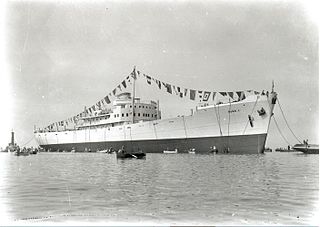
The Italian ship Ramb I was a pre-war "banana boat" converted to an auxiliary cruiser in World War II. Ramb I operated as an armed merchant in the Red Sea and was ordered to sail to Japan after the fall of Massawa to the Allies. She was sunk in the Indian Ocean before she could reach her intended destination.

Economic history of Somalia is related to the development of Somalia's economy in the last two centuries.
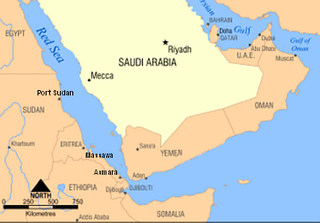
The Red Sea Flotilla was part of the Regia Marina Italia based at Massawa in the colony of Italian Eritrea, part of Italian East Africa. During World War II, the Red Sea Flotilla was active against the East Indies Station of the Royal Navy from the Italian declaration of war on 10 June 1940 until the fall of Massawa on 8 April 1941.

The Italian auxiliary cruiser Ramb III was built at Genoa by Ansaldo in 1938.

Ramb IV was an Italian hospital ship, built at Monfalcone by the United Yards of the Adriatic in 1938.

The Italian auxiliary cruiser Ramb II was a pre-war banana boat built at Monfalcone by the CRDA in 1937. She briefly served as an auxiliary cruiser with Regia Marina early in World War II before becoming an auxiliary transport with the Imperial Japanese Navy later in her career.
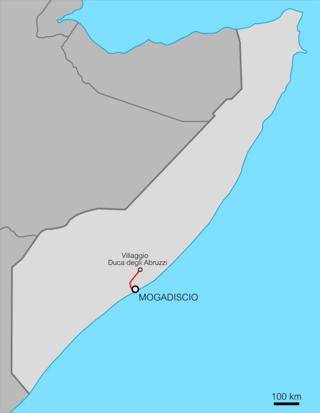
The Mogadiscio–Villabruzzi Railway is an historical railway system that ran through southern Somalia. It was constructed between 1914 and 1927 by the colonial authorities in Italian Somaliland. The railway connected the capital city Mogadishu with Afgooye, and subsequently with Villaggio Duca degli Abruzzi – usually called "Villabruzzi". The line was later dismantled by British troops during World War II. Plans for re-establishing the railway were made in the 1980s by the Siad Barre administration, but were aborted after the regime's collapse.

The Battle of the Strait of Otranto was a minor naval skirmish on 12 November 1940 during the Battle of the Mediterranean in World War II. It took place in the Strait of Otranto in the Adriatic Sea, between Great Britain and Italy.

Railway transport in Somalia consisted of the erstwhile Mogadishu–Villabruzzi Railway and secondary tracks. The system was built during the 1910s by the authorities in Italian Somaliland. Its track gauge was 950 mm, a gauge favoured by the Italians in their colonies in the Horn of Africa and North Africa. The railway was dismantled in the 1940s by the British during their military occupation of Italian Somaliland, and was subsequently never rehabilitated.
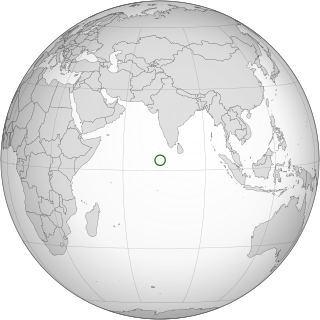
The action of 27 February 1941 was a single ship action between the British cruiser HMS Leander and the Italian auxiliary cruiser Ramb I. It began when Leander ordered an un-flagged freighter to stop for an inspection. The freighter raised the Italian colours and engaged Leander which sank Ramb I shortly after. Most of the Italian crew were rescued and taken to Addu Atoll, then Ceylon. Leander patrolled southwards to investigate more reports of commerce raiders.
This is a list of words, terms, concepts, and slogans in the Italian language and Latin language which were specifically used in Fascist Italian monarchy and Italian Social Republic.

Italian Ethiopia, also known as the Italian Empire of Ethiopia, was the territory of the Ethiopian Empire which was occupied by Italy for approximately five years. Italian Ethiopia was not an administrative entity, but the formal name of the former territory of the Ethiopian Empire which now constituted the Governorates of Amhara, Harar, Galla-Sidamo, and Scioa after the establishment of Italian East Africa.

The Port of Mogadishu, also known as the Mogadishu International Port, is the official seaport of Mogadishu, the capital of Somalia. Classified as a major class port, it is the largest harbour in the country.

Vittorio di Africa was a small town in southern Italian Somalia, created by Italian colonists in the late 1920s near the southern Shebelle river.

Genale is a town founded by Italian colonists in the southeastern Lower Shebelle region of Italian Somalia. Currently it is called Janaale.

The Imperial Line was a flight route of the Italian national airline Ala Littoria between 1935 and 1941 during the Fascist era. It was the longest route in the Italian colonial empire in Africa and "the jewel in Ala Littoria's crown". It connected Rome with Benghazi (Libya), Asmara (Eritrea), Addis Abeba (Ethiopia) and Mogadishu (Somalia). It carried passengers and mail. Italy ultimately lost control of the route during World War II.






















